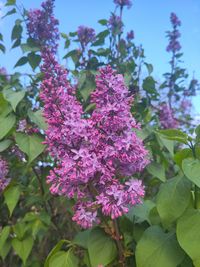Issued on April 17, 2025
Sunshine allows intense pollen count over the Easter weekend!
With the exception of Good Friday, the weather forecast for the coming days promises plenty of sunshine and temperatures above 20 °C. While short-term relief is expected on Friday, intense pollen counts are to be expected for the rest of the Easter weekend.
Birch pollen continues to make up the largest share of the pollen spectrum. While the peak of the birch blossom has already passed in the lowlands and valleys, it is still underway in the middle and higher altitudes and can lead to high to very high levels there. If the wind conditions are right, the birch pollen can be transported to the lowlands and valleys, where it can again cause more intensive pollution. Otherwise, only low to moderate exposure is to be expected.
The pollution is further intensified by the flowering of hornbeams. However, here too, many plants have already largely exhausted their flowering potential and can only release a small amount of pollen.
Instead, an increasing amount of beech and oak pollen is registered in the ambient air, which can also cause stress in birch pollen allergy sufferers due to cross-reactions.
In the south of Austria, the hop hornbeam also still causes exposure and can also lead to cross-reactions in birch pollen allergy suffer ers.
The sycamore tree is in bloom and will also cause exposure during the Easter weekend along avenues of sycamore trees or other large clusters of this tree species.
Exposure to ash pollen is coming to an end. People who are sensitized to olive tree pollen may only experience local symptoms again when the ash tree starts to flower.
As the lilac, which also belongs to the olive tree family, is currently in flower, people may also be exposed to its pollen. This ornamental shrub only produces a small amount of pollen compared to ash, as it is pollinated by insects. Allergic reactions are therefore only to be expected in the event of direct contact. Nevertheless, a bouquet of lilacs on the Easter table should be avoided by sensitized persons in order to prevent exposure.
The data from the flowering readiness model for this year's grass pollen season indicate that flowering readiness will be reached between the end of April and the beginning of May. During phenological observations, the first flowering bluegrasses, foxtail grasses and bunch grasses have already been spotted. They are already releasing pollen and can lead to low levels of contamination locally.
The white flakes that can already be seen sporadically in the air are poplar absorbent cotton. It cannot itself cause allergic reactions as it is not pollen but poplar seeds and seed hairs. As the flight of poplar absorbent cotton usually coincides with the start of grass flowering, symptoms are often wrongly attributed to poplar.
Other types of pollen in the ambient air: maple, boxwood, yew, mulberry, carnations, roses, sour grasses, walnuts and cypresses. These are of minor allergological importance.
| Flowering grasses | at |
|---|---|
Bregenz | 05.05.2025 |
Eisenstadt | 30.04.2025 |
Graz | 30.04.2025 |
Innsbruck | 30.04.2025 |
Klagenfurt | 02.05.2025 |
Linz | 01.05.2025 |
Salzburg | 02.05.2025 |
St. Pölten | 02.05.2025 |
Vienna | 30.04.2025 |
Munich | 04.05.2025 |
Bolzano | 24.04.2025 |
Forecast from 17.04.2025
Note: The data shown here are model data for the expected start of flowering. For more detailed information on the expected pollen count, please refer to the text forecasts.
Responsible for the content
AZ Pollenresearch GmbH
im Auftrag des Vereins Österreichischer Polleninformationsdienst in Kooperation mit der GeoSphere Austria.
Dr. med. Markus Berger, Dr. rer. nat. Johannes M. Bouchal und Lukas Dirr, MSc.
Wetterdaten und Prognosen basierend auf synoptischen Daten:
GeoSphere Austria, Bundesanstalt für Geologie, Geophysik, Klimatologie und Meteorologie (ehemals ZAMG)
zum Team


